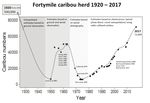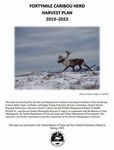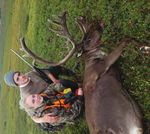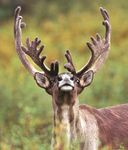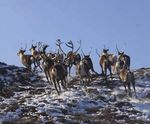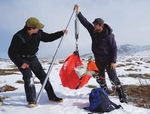The Comeback Trail News of the Fortymile Caribou Herd
←
→
Page content transcription
If your browser does not render page correctly, please read the page content below
The Comeback Trail
News of the Fortymile Caribou Herd
Summer, 2021
An update and explanation about the recent harvest strategy for the Fortymile caribou herd.
Based on more than 30 years of monitoring vital data and population size, ADF&G biologists have
concluded that the Fortymile caribou herd has likely entered a population decline due to compromised
nutrition caused by overgrazing of its range.
This information outlines efforts to mitigate the potential for long-term impacts
to the herds range from continued overgrazing by large numbers of caribou. After
reviewing all available data, managers concluded that the best strategy is to use
hunter harvest to rapidly reduce the herd size to allow nutritional condition to
improve to the point of slowing or arresting the population decline.
Recent actions
The herd started to show signs of declining nutrition as it approached and exceeded
5,000 caribou about 2010. As the herd continued to increase and the signs of
declining nutrition continued, the goal for Regulatory Year 2020 was to reduce the
herd size by up to 10,000 animals through harvest and to continue monitoring key nutritional indicators.
Our intent is to slow harvest once the population is reduced below 50,000 caribou, allowing the range to recover and
nutritional condition to improve.
The 2020 season included an either sex fall hunt during August 10–September 30, with a bag limit of 2 caribou and a
harvest objective of 5,000. There was a reported harvest of 5,533. By late February, 2021 the winter hunt bag limit was
increased to 3 caribou to provide additional hunting opportunity and to make progress toward achieving the desired
total harvest. The winter hunt harvest was 1,783 animals. The total number of caribou harvested was 7,316. Harvest
combined with natural mortality likely achieved the desired reduction of 10,000 caribou.
Fairbanks, AK 99701
1300 College Road
Division of Wildlife Conservation
Alaska Department of Fish and GameHow do we know the herd is too large?
Indicators that the herd is experiencing nutritional stress include a decline in the birth When caribou overshoot the
rate of 3-year old cows, a decline in 4-month calf weights, and a decline in newborn population that their habitat can
calf weights. Biologists closely study these indices to look at changes and trends. support, the effects of high density,
adverse weather, and increased
3-year-old parturition (birth) rates predation can have interactive
negative effects on caribou numbers
Birth rates among radio-collared 3-year-old female caribou during 1993–2020 and long-lasting negative effects on
indicate a significant decline in the number of 3-year old cows giving birth. Cows in sustainable harvest.
the Fortymile herd should generally give birth to their first calf when they are 3 years
old. Using a 5-year moving average (to account for unusual harsh weather years), the 3-year-old birth rate was below
the 55% management threshold in 2018, 2019, 2020, and 2021. This indicates a significant reduction in reproductive
capability of cows as the age of reproduction is delayed for many cows until they are 4 years old. Declining nutritional
condition, not weather, is implicated in this decline, indicating that it is prudent to decrease the population.
4-month old calf weights
Declining October calf weights are another sign of reduced nutritional condition.
The trend of female calf weights at 4 months of age indicate a significant decrease
of more than ⅓ pound per year during 1990–2020. October calf weights in 2020
were within 1 pound of the lowest recorded calf weights on record for the herd.
October calf weights during 2017–2020 were significantly below the long-term
average in 3 out of the 4 years.
Newborn calf weights
Average newborn female calf weights of 14.5 pounds in 2020 were the lowest
ever recorded for the Fortymile herd and data collected from 2015-2021 indicate a
continued declining trend in newborn calf weights. Risk of death during the first year
of life increases with declining newborn weight.
Declines in Interior Alaska caribou herd populations have been seen when newborn
female calf weights declined to below 13 pounds. Recent Fortymile newborn calf
weights approaching this threshold is further indication that it is prudent to decrease
the population to a more sustainable level.
Verification of the problems
Prior to the 2020-2021 winter hunt, biologists monitored survival and movements
of adults and calves, assessed body condition of caribou harvested in August, and
conducted a composition survey (percentage of bulls, cows, and calves) on the herd
in early October. Additionally, 40 female calves were captured and weighed. Twenty
of those were lethal captures and included a necropsy to assess body condition and
disease prevalence providing more insight on the current health status of the herd.
The meat from the lethal captures was donated to charity.
Results of these efforts indicated the herd remained in poor condition and further
reduction was advised. Managers set the winter harvest quota and bag limit
accordingly at a bag limit of 2 caribou (either sex) with a harvest quota of 5,000
caribou. The bag limit was eventually increased to 3 caribou to try to to provide
additional harvest opportunity and make additional progress toward achieving the harvest quota.
Recent multi-year vital rate data collected by ADF&G, in cooperation with the U.S. Bureau of Land Managment, and the Yukon Department of
Environment, shows a striking resemblance to herds in other parts of the state that have experienced precipitous declines.Additional data
4-month old calf femur marrow fat
In addition to live body weight, the average percent femur marrow fat in female
calves during October is a valuable index of herd condition. Calves in very good
condition should have about 80–90% fat in the femur.
The mean percent fat of the 20 female calves sampled in October was 61%.
This is similar to many of the fall samples from the Northern Peninsula and
Mulchatna herds in the mid-1990s, before those herds dramatically declined.
It is clear that these calves were entering the winter in less than optimal
condition. These data added further insight into the nutritional condition of
the herd and provided support for our decision to further decrease herd size
through harvest.
Adult female survival
The 2019–2020 adult female survival estimate of 83% is below the long-term trend. Low adult survival negatively affects
the population trajectory, and is another indicator that this population is in decline.
The population size
Obtaining a good population estimate for caribou is very challenging. All of the environmental conditions must align
perfectly for the caribou to group up and become available for the photocensus airplane to aquire high quality digital
images. For many herds there is only one chance each year when this occurs. For the Fortymile herd the perfect
conditions have not occurred since the last succesful photocensus in 2017.
Early 1920s - ADF&G
Boertje et al. 2012
262,000
Counting Caribou
For a closer look at how ADF&G tracks
caribou numbers,
check out this short
video summarizing the
methods used to estimate
populations in Alaska.
Watch it online:
youtu.be/7czVasU-WCw
In the absence of a population estimate each year, or every other year, it becomes even more important for biologists
to keep a close eye on the nutritional indicators listed above. Whether or not a population estimate is achieved, the
combined indicators provide evidence of the likely direction that the herd is going.
If more caribou are dying annually than are being born— female production is declining, fewer calves are being
born, fewer calves are surviving, adult females survival is declining, etc.—then the herd is in a decline. Our current
management goal is to reduce the herd to a sustainable level before further range damage occurs triggering a dramatic
population decline.Hunter samples Thanks to all the hunters who turned in their required jaw samples this past winter. The data collected from these jaws may help in future monitoring and management of the herd. The front teeth are extracted to obtain the age of the animal and tissue is sampled to obtain DNA for genetic analyses. With age and DNA from harvested animals, research biologists may be able to assess the genetic relationship among harvested individuals. If the research proves effective, this data may provide information about population size and trend. Fall 2021(RC 860)- No samples are required on the permit, but ADF&G staff will be in the field contacting hunters and collecting some samples. Winter 2021/22 (RC 867)- Similar to last year's RC867 winter hunt, hunters will be required to collect and turn in the lower jaw (4-inch section) from harvested caribou. Fortymile harvest management plan The current Fortymile Caribou Herd Harvest Plan covers regulatory years 2019-2023. It was developed by the Harvest Management Coalition to provide recommendations to the management agencies in Alaska and Yukon to 1) guide harvest management of the Fortymile Caribou Herd in Alaska, and 2) for allocation of an annual allowable harvest between Alaska and Yukon. The entire plan, which includes more information about the Harvest Management Coalition, is available on the ADF&G website: https://www.adfg.alaska.gov/static/research/plans/pdfs/ fortymile_harvest_plan_2019_2023.pdf or you can point your phone camera to the QR code and it will bring you to the plan. Respect land status, and follow safe, and ethical hunting practices Hunters should be aware that some BLM lands accessible from the Steese Highway are closed to ATVs. BLM has 3 maps that hunters can reference on the BLM website about ATV use off the Steese Highway. They are titled: "Steese National Conservation Area", "White Mountains National Recreation Area", and "Pinnell Mountain National Recreation Trail Map". And on the Taylor Highway side in Zone 3, hunters can look at the "Fortymile National Wild and Scenic River/Taylor Highway" BLM map by following the same link. Maps are available at the BLM and ADF&G offices in Fairbanks, Tok ADF&G, and are also online. Find more information and links to the maps at the BLM site: https://www.blm.gov/maps/georeferenced-PDFs There have been many reports of unsafe and unethical hunting practices during the Fortymile hunt along the Steese highway. This can result in a bad image for all hunters. Please practice safe hunting and shooting, don't shoot into groups of animals, know your abilities and only shoot at individual animals that you know you can kill, follow all meat salvage requirements, don't leave gut piles by the the side of the highway or in parking areas, and never chase caribou with motorized vehicles.
You can also read




